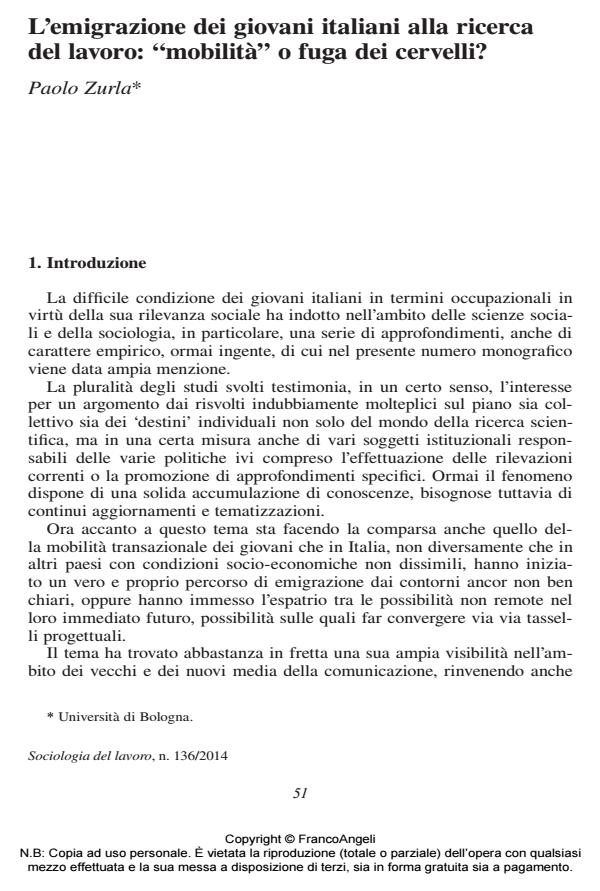The emigration of Italian young people seeking for a job: "mobility" or "brain drain"?
Journal title SOCIOLOGIA DEL LAVORO
Author/s Paolo Zurla
Publishing Year 2014 Issue 2014/136
Language Italian Pages 20 P. 51-70 File size 180 KB
DOI 10.3280/SL2014-136004
DOI is like a bar code for intellectual property: to have more infomation
click here
Below, you can see the article first page
If you want to buy this article in PDF format, you can do it, following the instructions to buy download credits

FrancoAngeli is member of Publishers International Linking Association, Inc (PILA), a not-for-profit association which run the CrossRef service enabling links to and from online scholarly content.
More and more often Italian young people decide to undertake an emigration path, most of the time within the European area. The main reason for their departure is connected to insufficient employment opportunities which cannot however provide an exhaustive explanation of the phenomenon. Those who leave are not only young people coming from a national disadvantaged environment, but also individuals who belong to the richest and most developed Italian regions from the socio-cultural point of view. Respect to the past migration models, the youth of today - often in possession of relevant educational qualifications (degree, master and PhD) - experience a different emigration pattern, which has gradually lost the feature of eradication from the context of origin in order to acquire the typical trait of the multiple belonging and of the reversible and changeable pathways. For its novelty and variability, but also for its relevance, the phenomenon does not have sufficient knowledge basis which will require a considerable in-depth analysis in the near future.
Keywords: Youth, mobility, Europe, brain drain, European citizenship
- Italian youth mobility: The case for a Mediterranean model of ‘family-centred’ mobile transitions Giulia Marchetti, Loretta Baldassar, Anita Harris, Shanthi Robertson, in Ethnicities /2022 pp.108
DOI: 10.1177/14687968211037083 - Percorsi di emigrazione in un paese non occidentale. Le esperienze di italiani a Shangai Marianna Chirivì, Grazia Moffa, in SOCIOLOGIA URBANA E RURALE 130/2023 pp.37
DOI: 10.3280/SUR2023-130003 - Continuities in intra-European mobilities: what’s novel in the new Spanish emigration? Diego López de Lera, in Ethnic and Racial Studies /2020 pp.2531
DOI: 10.1080/01419870.2020.1738517 - Tra lavoro e partecipazione. Tracce di protagonismo giovanile Alessandro Martelli, Paolo Zurla, in SOCIOLOGIA E RICERCA SOCIALE 118/2019 pp.124
DOI: 10.3280/SR2018-117008
Paolo Zurla, L’emigrazione dei giovani italiani alla ricerca del lavoro: "mobilità" o fuga dei cervelli? in "SOCIOLOGIA DEL LAVORO " 136/2014, pp 51-70, DOI: 10.3280/SL2014-136004